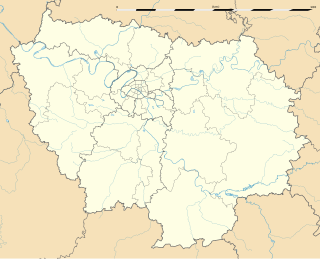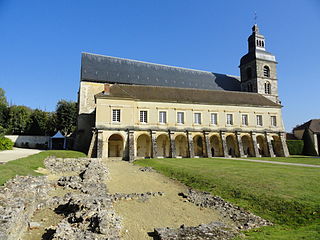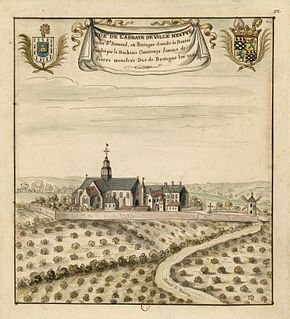
Bec Abbey, formally the Abbey of Our Lady of Bec, is a Benedictine monastic foundation in the Eure département, in the Bec valley midway between the cities of Rouen and Bernay. It is located in Le Bec Hellouin, Normandy, France, and was the most influential abbey of the 12th-century Anglo-Norman kingdom.

The Roman Catholic Archdiocese of Reims is an archdiocese of the Latin Rite of the Roman Catholic Church in France. Erected as a diocese around 250 by St. Sixtus, the diocese was elevated to an archdiocese around 750. The archbishop received the title "primate of Gallia Belgica" in 1089.

The Roman Catholic Diocese of Troyes is a diocese of the Latin Rite of the Roman Catholic Church in Troyes, France. The diocese now comprises the département of Aube. Erected in the 4th century, the diocese is currently suffragan to the Archdiocese of Reims. It was re-established in 1802 as a suffragan of the Archbishopric of Paris, when it comprised the départements of Aube and Yonne and its bishop had the titles of Troyes, Auxerre, and Châlons-sur-Marne. In 1822 the See of Châlons was created and the Bishop of Troyes lost that title. When Sens was made an archdiocese, the episcopal title of Auxerre went to it and Troyes lost also the département of Yonne, which became the Archdiocese of Sens. The Diocese of Troyes covers, besides the ancient diocesan limits, 116 parishes of the ancient Diocese of Langres and 20 belonging to the ancient diocese of Sens. On 8 December 2002, the Diocese of Troyes was returned to its ancient Metropolitan, the Archbishop of Reims.
Mary Seton was a Scottish courtier and later a nun. She was one of the four attendants of Mary, Queen of Scots, known as the Four Marys. She was a sister at the Convent of Saint Pierre les Dames in Reims at the time of her death.

The Roman Catholic Diocese of Le Mans is a Roman Catholic diocese of France. The diocese is now a suffragan of the Roman Catholic Archdiocese of Rennes, Dol, and Saint-Malo but had previously been suffragan to Bourges, Paris, Sens, and Tours.

Robert de Lenoncourt was a French bishop, Cardinal, and diplomat. He was the son of Thierry de Lenoncourt, Seigneur de Vignory, Councillor and Chamberlain of the King, and Jeanne de Ville. He had a brother, Henry, Sire de Lenoncourt and Baron of Vignory, a sister named Jacquette, who married Jean d'Aguerre, son of the Governor of Mouzon, and a sister named Nicole, who married Érard du Châtelet. Robert's paternal uncle, also called Robert de Lenoncourt, was Archbishop of Reims.

Orbais-l'Abbaye is a commune in the Marne department in north-eastern France. The abbey at Orbais was founded at the end of the 7th century by Saint Réol, and the remains are situated in the centre of the town.
Gerald of Sales was a French monastic reformer from Salles, Lot-et-Garonne near Bergerac, Dordogne in the south-west of France. His feast day is on April 20.

Maubuisson Abbey is a Cistercian nunnery at Saint-Ouen-l'Aumône, in the Val-d'Oise department of France. It was founded in A.D. 1236 by Blanche of Castile, Queen of France, who may have been buried there in 1252. The site is now within the north-western suburbs of Paris. The surviving buildings are listed as a monument historique.

Signy Abbey was a Cistercian abbey located in Signy-l'Abbaye, Ardennes, France. It is located about 65 kilometres (40 mi) northeast of Reims and about 28 kilometres (17 mi) west of Charleville-Mézières on the edge of the Froidmont forest. It was founded on 25 March 1135, the feast day of the Annunciation. It was sold as national property in 1793 and completely demolished. Its library was burned.

Igny Abbey or Val d'Igny Abbey is a Cistercian abbey located in Arcis-le-Ponsart, Marne, France. It was founded in 1128 for Cistercian monks, dissolved in 1791 during the French Revolution, re-established in 1876 for Trappist monks, destroyed in 1918, reopened in 1929 for Trappist nuns and modernised in 2008–12 to accommodate three or four pre-existing communities.

Hautvillers Abbey, or more formally the Abbey of St Peter, Hautvillers, is a former Benedictine monastery in the Hautvillers commune of the Marne department in north-eastern France. The abbey remained active between 665 and the French Revolution of 1789. It housed the relics of Saint Helena, Empress and mother of Constantine, between 841 and 1819. One of its monks, Dom Pérignon, contributed to the development of sparkling wine in the Champagne region. The building has been classified as a monument of historical value since 1983.

The Abbey of Saint-Sauveur-le-Vicomte, located in the commune of Saint-Sauveur-le-Vicomte in the Manche department of France, was a Benedictine monastery founded in the 11th century by Néel de Néhou, Vicomte of Saint-Sauveur. The abbey has longstanding connections with the nearby Channel Islands. After being dissolved in the French Revolution it became in the 1830s the mother house of the Sisters of Christian Schools of Mercy, now the Congregation of Saint Marie-Madeleine Postel.

The Abbey of St. John, Laon was a Benedictine monastery in Laon, France, from 1128 to 1766, which replaced a nunnery founded in 641. The prefecture of the department of Aisne now occupies the site.

Félicie-Marie-Emilie d'Ayzac (1801–1881) was a French poet and art historian. She is remembered for her poetry collection Soupirs poétiques (1833) and for her Histoire de l'abbaye de Saint-Denis.

Villeneuve Abbey, dedicated to Our Lady, was a Cistercian monastery at the present-day Les Sorinières, near Nantes in Pays de la Loire, France, founded in 1201 and dissolved in 1790, during the French Revolution.

Les Écharlis Abbey is a former Cistercian monastery in Villefranche, Yonne, France. It was founded in the 12th century by a secular priest with two companions who wanted to live a monastic life. Soon afterward, the monastery joined the Cistercian order as a dependency of Fontenay Abbey.














